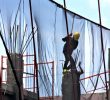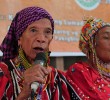By GERMELINA A. LACORTE
Davao Today
Alan Codizar�s family noticed the smell after two months inside their house in Catalunan Grande, a village about five kilometers from downtown Davao. �We thought it was the dog,� recalled Codizar�s wife Lourdes, �So, we moved the doghouse somewhere else but still the smell lingered.�
Later, they opened the sewage at the back of the house and noticed that the pipes were leaking.
The house was one of the low cost housing units of the South Villa Heights 2 awarded to them in 1994 under the Unified Home Lending Program (UHLP). But they only assumed it two years ago because the area did not have an access road and it was very far from their place of work.

One of the houses on South Villa not taken by homeowners and later classified delinquent by the NHMFC. (davaotoday.com photo by Germelina Lacorte)
When they took over, the one-room 90-sq. meter house looked like an empty matchbox. They put up jalousies on the windows, installed the doors and the tiles on the floors and later, the sewage pipes. �There were cracks even at the ceiling,� Lourdes said, �We can�t even nail something on the wall without feeling that the house would crumble.�
Just a couple of blocks away, Vidal Payao, 60, had lived in the area since the late 1990s but refused to pay for his amortization.
Together with 60 other homeowners, Payao sued subdivision developer Robern Development Corporation in 1994 for the substandard quality of the housing units.
�They used dilapidated plywood,� Payao said. �The sewage pipe was leaking and the drainage was so bad. They did not follow the prescribed plan. There was no light and water. Until the developer fixed our units, we refuse to pay.�
Robern denied Payao�s claims but an inspection by the Housing Land Use and Regulatory Board (HLURB) showed cracks on the walls, leaking sewage pipes among other deficiencies in the South Villa houses.
Payao and the South Villa homeowners won the case in 2000 but the HLURB Legal Services Group did not justify the homeowners� refusal to pay their dues.
Lawyer Donna Ladao, housing and land use arbiter, ordered the developer to fix the houses, build an access road, drainage system and install the water supply in the area.
But she cited Section 23 of PD 957, saying that buyers can only suspend amortization payments to the owner or subdivision developer, but not to the lending or financing institutions where they secure loans for their housing units. Their contract with the developer is totally separate from their contract with their financier, said Lawyer Miguel Palma Gil, HLURB arbiter for Mindanao.
Payao, however, was surprised in late 2007 to receive foreclosure orders from Balikatan Housing Finance Inc., a company created to absorb the high delinquent loans of the National Home Mortgage and Finance Corporation (NHMFC).
The South Villa 2 housing units were among those classified as �high delinquent� loans that sent the NHMFC reeling in the 1990s, a condition that the country�s financial experts regarded as the Philippines� early version of the US subprime mess that recently sent banks around the globe in the brink of collapse.
Choking in toxic debts, the NHMFC only averted its own collapse by auctioning off these highly delinquent loans in the market in 2004. The sale involved 52,000 high delinquent loans, with an outstanding principal balance of P12 billion and a total amount due of P30 billion. Among these accounts, were 6,000 housing units in Davao city, involving 16 low cost subdivisions including the South Villa Heights.
Deutsche Bank purchased the non performing loans and together with the NHMFC, put up the Balikatan�a company 49 per cent owned by NHMFC and 51 per cent owned by Deutsche Bank�and its holding company Bahay Financing Services Inc. to carry out its restructuring program.
Lawyer Gerald Paez, head of the Balikatan corporate communication development, defined �highly delinquent� accounts as those which were not paid in the last 15 years.
City officials, however, questioned the government agency�s sell off, saying that it is a remission of the government�s duty to provide affordable housing to its citizens.
Danilo Dayanghirang, city councilor, said Celso de los Angeles, who has been involved in the controversial Legacy deal, used to sit as chair of the NHMFC Board when the government agency initiated the sell off of the delinquent loans. Mayor Rodrigo Duterte also appealed to President Arroyo to temporarily put a cap on the foreclosure order and to give homeowners more affordable payment terms.
Although the government had created the NHMFC in 1977 to develop and provide a secondary market for home mortgages, NHMFC was also mandated to complement the government�s low cost housing program.
Experts believe the secondary mortgage market will �unlock� opportunities in banks to lend more to the housing sector at affordable rates by allowing the NHMFC�borrowing
funds from the SSS, the GSIS and the Pag-ibig�to buy these mortgages and securitize it to potential investors.
But in 1986, the Aquino government issued Executive Order 90, placing upon the NHMFC�s hands the management and development of the Unified Home Lending Program (UHLP), which finances housing for the poor.
Borrowing P42 billion funds from Social Services System (SSS), the Government Services Insurance System (GSIS) and the Home Development Mortgage Fund (HDMF) more popularly known as Pag-ibig, the NHMFC provided mortgage financing to approximately 220,000 homeowners from 1987 to 1996.
But the NHMFC did very poorly in screening applicants and in collecting their dues. In the middle 1990s, the government agency was choking in toxic debts. It could not collect enough from the housing borrowers and at the same time, it could not pay the accruing balance for its loans.

Homeowner Vidal Payao won the case against developer Robern Development Corporation over substandard housing units. (davaotoday.com photo by Germelina Lacorte)
This was also the time when a housing boom fueled massive production of houses in the region that it was hard for government agencies to monitor their quality, observed Palma Gil.
Jose Macuto, NHMFC head of the Davao regional office, said the government agency has strictly set the formula for those who could afford to borrow. �Their amortization should not be higher than a third of their monthly income,� he said. �Actually, they had the capacity to pay but they refused to pay,� he said.
When Codizar received a foreclosure notice on his property, he has already spent over P100,000 for the improvement of the house. At present, Codizar�s delinquency ran up to P887 thousand, a hefty sum for someone getting only a meager P279 a day (or P8,800 a month), and whose household expenses with his two children and his wife could easily run up to P6,600 a month.
One of the four options that Balikatan offered was a �refinancing scheme� that allowed him to settle his account for a certain period of time based on the current appraised value of the property.
Now deluged by a flurry of demand letters and foreclosure orders, homeowners like Payao continue to demand their basic right as consumers. Bracing against the prospect of losing their homes, they formed the group Anti-Foreclosure Alliance, questioning the government�s sell out. �I would demand for quality of the house that I buy,� said Payao. �I will pay once they deliver. But what we have here are broken windows, rotting sewers in houses not even worth living in.� (Germelina Lacorte/davaotoday.com)
Poverty









